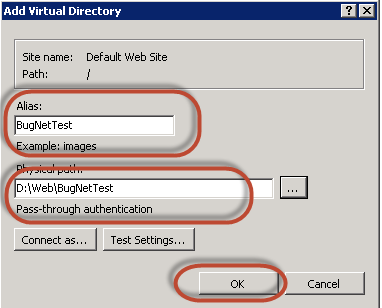BugNET is an issue tracking and project issue management solution built using C# and ASP.NET . The main goals are to keep the codebase simple, well documented, easy to deploy and scalable. You can found BugNet project on CodePlex and now, we are going to try installing BugNET. Here are the easiest way to install BugNET:

1. First, Log in to your database server with a user who has sufficient privileges.
2. Create a database on your SQL Server , you can name it for example: BugNetDatabase.
3. Create a new login. I used the same name for the database and the login.
4. I disabled Enforce password expiration since this is my local server on the intranet. You can also set Windows authentication. Set the membership on the BugNetDatabase.
5. Now that you have database user/connection, you can deploy the package on web server. The instructions on codeplex site are clear. I let myself to copy these instructions here to comment them or to show how I modified. All the information in bold, blue is copied from codeplex site.
6. Download the latest stable release of BugNET, using the INSTALL package.
7. Extract the contents of the install package to a folder on your computer.Create a directory in the c:\inetpub\wwwroot\ folder called bugnet (c:\inetpub\wwwroot\bugnet)
hen you must Copy the contents of the extracted BugNET INSTALL package to the c:\inetpub\wwwroot\bugnet\ folder. In the zip folder you downloaded, you'll find 2 folders.Go to the properties of the c:\inetpub\wwwroot\bugnet\ folder, click on the Security tab, be sure to add the permissions for the appropriate user (WinXP/2000 uses the local ASPNET account, Win2003/Vista/2008/7 use the local Network Service account). Give this account modify permissions on the folder.
- Uploads: if you using file system based uploads
- App_Data : This folder is where BugNET stores its database.- web.config - the application installer will create a unique machine key for password encryption during the installation process.
8. Open up the the web server IIS Console.
- Click start button -> then, type run -> type INETMGR then ENTER.Create a virtual directory in IIS for the bugnet folder.
- Expand the websites node
- Expand the default websites node
Right click on the BugNET folder under the default website, click on Convert to Application, if you don't have that option, choose properties and then add the application.

9. After that, don’t forget to configure your server. The last thing that isn't mentioned on the official instructions : configuring web.config to let BugNet to communicate with your database. You can replace the following code:
<connectionStrings>
<clear/>
<add name="BugNET" connectionString="Data Source=.\SQLEXPRESS;Database=BugNET;Integrated Security=True;" providerName="" />
</connectionStrings>
With
<connectionStrings>
<clear />
<add name="BugNET" connectionString="Server=XXX.XXX.XXX.XXX;Database=BugNetTest;User ID=bugnettest;Password=XXXXXXX;" providerName="System.Data.SqlClient" />
</connectionStrings>
Finally, you can connect to the site with your favorite web browser using the following link:
http://localhost/BugNetTest/Install/Install.aspx
Browse again to http://localhost/BugNetTest/. As indicated on the codeplex site for the first connection use admin/password.